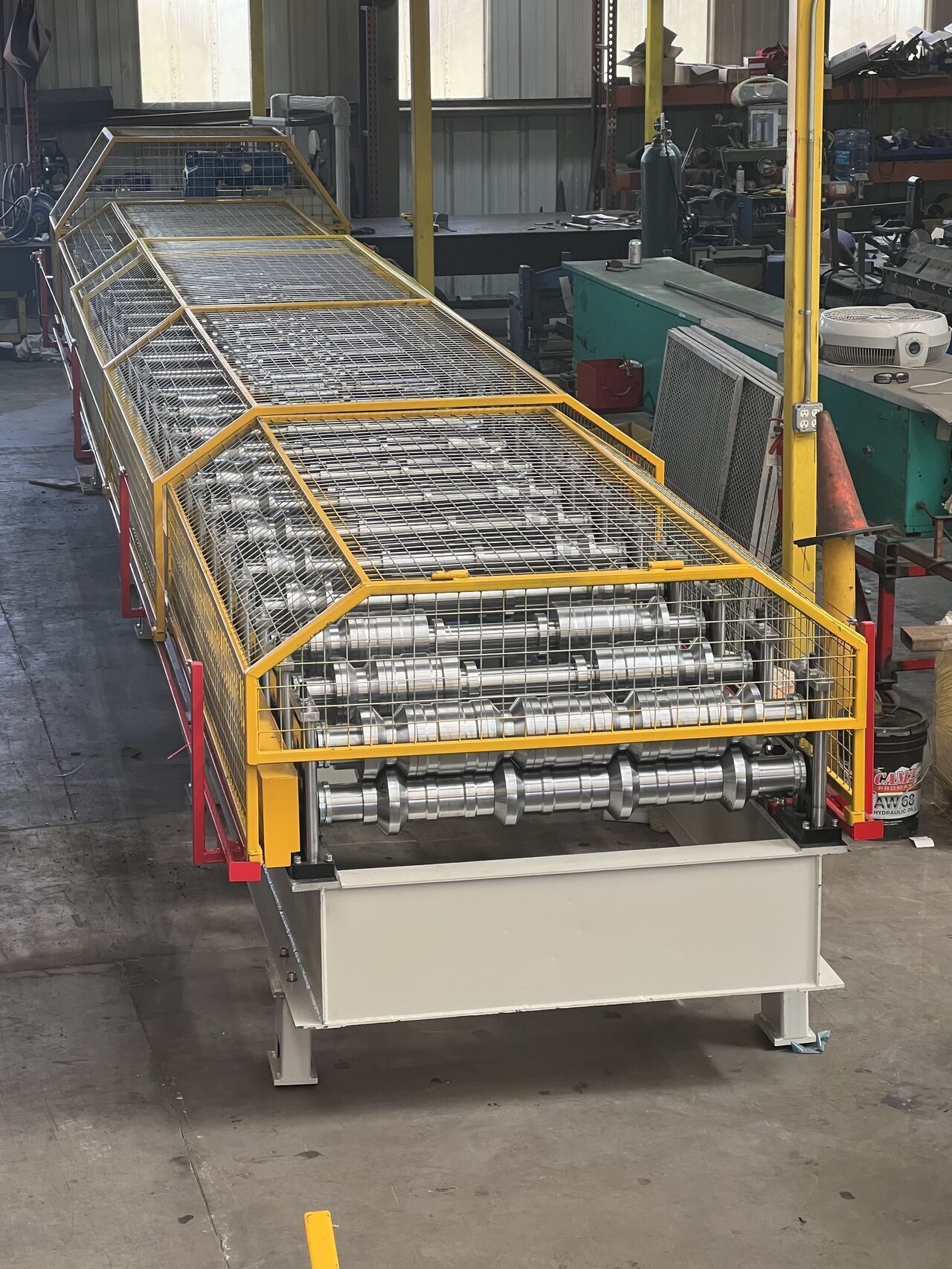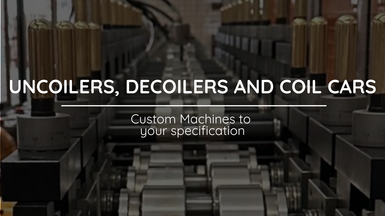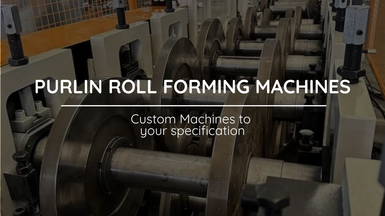
Metal Siding Machine
Here's how a typical metal siding machine works:
Posted on Monday, November 27, 2023
A metal siding machine, also known as a roll forming machine or siding roll former, is a piece of industrial equipment used in the construction and manufacturing industry to produce metal siding panels or sheets. Metal siding is a popular choice for building exteriors due to its durability, weather resistance, and low maintenance requirements.
Here's how a typical metal siding machine works:
- Material Loading: The process begins with loading a coil of metal sheet or strip material onto the machine. Common metals used for siding include steel, aluminum, and sometimes copper.
- Uncoiling: The machine has a mechanism to uncoil the metal coil and feed it into the roll forming section.
- Roll Forming: The heart of the machine is the roll forming section, which consists of a series of rollers that gradually shape the flat metal sheet into the desired profile or pattern. Each roller set is responsible for forming a specific part of the siding profile, such as the waves, ribs, or seams. The rollers are precisely designed to create the correct dimensions and shapes for the siding panels.
- Cutting: After the metal sheet has been roll-formed into the desired shape, a cutting mechanism is used to trim the siding panels to the desired length. Some machines have flying cut-off blades that can make continuous cuts as the metal is formed, while others have a separate cutting station.
- Stacking or Packaging: Once cut to the appropriate length, the finished siding panels are either stacked for further processing or packaged for shipping and distribution.
Metal siding machines come in various sizes and configurations, depending on the specific siding profile and production requirements. Some machines are designed for high-volume industrial production, while others are more compact and suitable for smaller-scale manufacturing or custom siding production.
The choice of a metal siding machine depends on factors such as the type of metal used, the desired siding profile, production volume, and budget. These machines can significantly speed up the production process and help ensure consistent and high-quality siding panels.
What panels can a User Metal siding machine make?
A user-operated metal siding machine, also known as a portable roll forming machine, is typically designed to produce a variety of siding panels and profiles commonly used in construction and building projects. The specific panels it can produce depend on the design and capabilities of the machine, as well as the tooling or roller sets that are available for it. Here are some examples of the types of siding panels that a user metal siding machine can make:
- Ribbed Panels: These panels feature raised ribs or corrugations that add strength and visual interest. They are commonly used for agricultural, industrial, and commercial buildings.
- Standing Seam Panels: Standing seam panels have vertical ribs that interlock with each other, creating a continuous, weather-resistant surface. They are often used on residential and commercial roofs and walls.
- Flush Panels: Flush panels have a flat, smooth surface without ribs or corrugations. They offer a sleek and modern look and are used in various architectural applications.
- Log Cabin or Wood Grain Panels: These panels are designed to mimic the appearance of wood siding, often with a textured surface that resembles wood grain. They provide the aesthetic of wood with the durability of metal.
- Shingle Panels: Shingle panels are designed to look like traditional roofing or siding shingles. They can add a unique visual element to a building's exterior.
- Tile Panels: Tile panels are designed to mimic the appearance of ceramic or clay tiles, offering a durable and cost-effective alternative.
- Board and Batten Panels: These panels consist of alternating wide and narrow sections, creating a classic board-and-batten appearance. They are often used in rustic or traditional architecture.
- Custom Profiles: Some user metal siding machines may allow for the creation of custom profiles or patterns, depending on the user's requirements.
The versatility of a user metal siding machine largely depends on the machine's design, the availability of different roller sets or tooling, and the user's ability to set up and adjust the machine for various profiles. These machines are often used by contractors and small manufacturers who need flexibility in producing different types of siding panels for specific projects or customer preferences.
What material would you use on a Metal siding machine?
A metal siding machine is typically used to work with various types of metal materials, as the name suggests. The choice of material depends on the specific requirements of the project, including factors such as aesthetics, durability, budget, and environmental considerations. Here are some common types of metal materials used with metal siding machines:
- Steel: Steel is one of the most common materials used for metal siding due to its strength and durability. It is available in various thicknesses and can be coated with protective finishes to enhance corrosion resistance. Steel siding can be painted in a wide range of colors and is suitable for both residential and commercial applications.
- Aluminum: Aluminum is known for its lightweight properties and resistance to corrosion. It is often used for siding in coastal areas or regions with high humidity. Aluminum siding is available in different styles and finishes and can be painted if desired.
- Copper: Copper is a premium metal siding material known for its distinctive appearance and longevity. Over time, copper develops a unique patina that adds character to a building. It is often used in upscale residential and architectural applications.
- Zinc: Zinc is another durable metal option for siding. It has a distinctive matte finish that weathers gracefully over time. Zinc siding is popular in contemporary and modern architectural designs.
- Galvanized Steel: Galvanized steel is steel that has been coated with a layer of zinc to provide extra corrosion resistance. It is a cost-effective option for metal siding, especially in agricultural and industrial settings.
- Stainless Steel: Stainless steel is highly resistant to corrosion and staining, making it suitable for harsh environments. It is often used in commercial and industrial applications where hygiene and durability are essential.
- Cor-Ten Steel: Cor-Ten steel, also known as weathering steel, develops a rust-like patina that provides natural protection against corrosion. It is used in contemporary and industrial designs for its unique appearance.
- Composite Panels: Some metal siding machines can also work with composite materials that combine metal with other materials like polymers or fiberglass to achieve specific performance characteristics, such as improved insulation or weight reduction.
The choice of material depends on factors like the desired appearance, climate conditions, budget, and architectural style. It's essential to consider the specific needs of your project and consult with professionals or manufacturers to determine the most suitable material for your metal siding machine.
Is it better to buy a new or used Metal siding machine?
Whether it's better to buy a new or used metal siding machine depends on various factors, including your budget, specific needs, and the condition of available used machines. Both options have their advantages and disadvantages, so it's important to carefully evaluate your situation before making a decision. Here are some considerations for each option:
Buying a New Metal Siding Machine:
- Reliability and Warranty: New machines typically come with warranties and are less likely to have hidden maintenance or repair issues. This can provide peace of mind and reduce the risk of unexpected expenses.
- Latest Technology: New machines often incorporate the latest technological advancements, which can improve efficiency, accuracy, and ease of use. They may also offer additional features or customization options.
- Better Performance: New machines are likely to operate at peak performance, providing consistent and high-quality output from the start.
- Longevity: New machines can have a longer lifespan, which may justify the higher upfront cost over the long term.
- Manufacturer Support: Manufacturers of new machines typically offer technical support, training, and spare parts, making it easier to maintain and service the equipment.
Buying a Used Metal Siding Machine:
- Cost Savings: Used machines are generally more affordable upfront, which can be advantageous if you have budget constraints.
- Immediate Availability: Used machines are readily available, and you may be able to find one that suits your needs without waiting for a new machine to be manufactured.
- Good Condition: Some used machines are well-maintained and in excellent working condition. If you can find one that has been properly cared for, it can be a cost-effective choice.
- Reduced Depreciation: New machinery typically depreciates rapidly in value, whereas the depreciation of a used machine may be less steep.
- Historical Performance: You can research the performance history and user experiences of specific used machines to get an idea of their reliability and suitability for your needs.
When considering a used metal siding machine, it's crucial to thoroughly inspect the equipment, check its maintenance records, and, if possible, have it tested or inspected by a qualified technician. Additionally, consider the age of the machine, the availability of spare parts, and whether any necessary upgrades or repairs will be cost-effective.
Ultimately, the decision to buy a new or used metal siding machine should be based on your budget, the specific requirements of your projects, and your comfort level with the condition and history of the used equipment available in your market. Both options can be viable, so it's essential to weigh the pros and cons carefully.
Roll Forming Machines LLC's New Factory
Posted on Sunday, March 23, 2025
We have relocated factories, which will be available for tours very soon.

Uncoiler, Decoiler and Coil Car Roll Forming Machine Accesories from Roll Forming Machines LLC
Posted on Sunday, November 24, 2024
Contact us today with your specifications for a custom Uncoiler, Decoiler or Coil Car at [email protected] or call us at (+1) (407) 859 1119

Stud and Track Roll Forming Machines from Roll Forming Machines LLC
Posted on Saturday, November 23, 2024
Contact us today with your specifications for a custom Stud and Track Machine at [email protected] or call us at (+1) (407) 859 1119

Cee and Zee Purlin Roll Forming Machines from Roll Forming Machines LLC
Posted on Saturday, November 23, 2024
Contact us today with your specifications for a custom Cee and Zee Purlin Machine at [email protected] or call us at (+1) (407) 859 1119